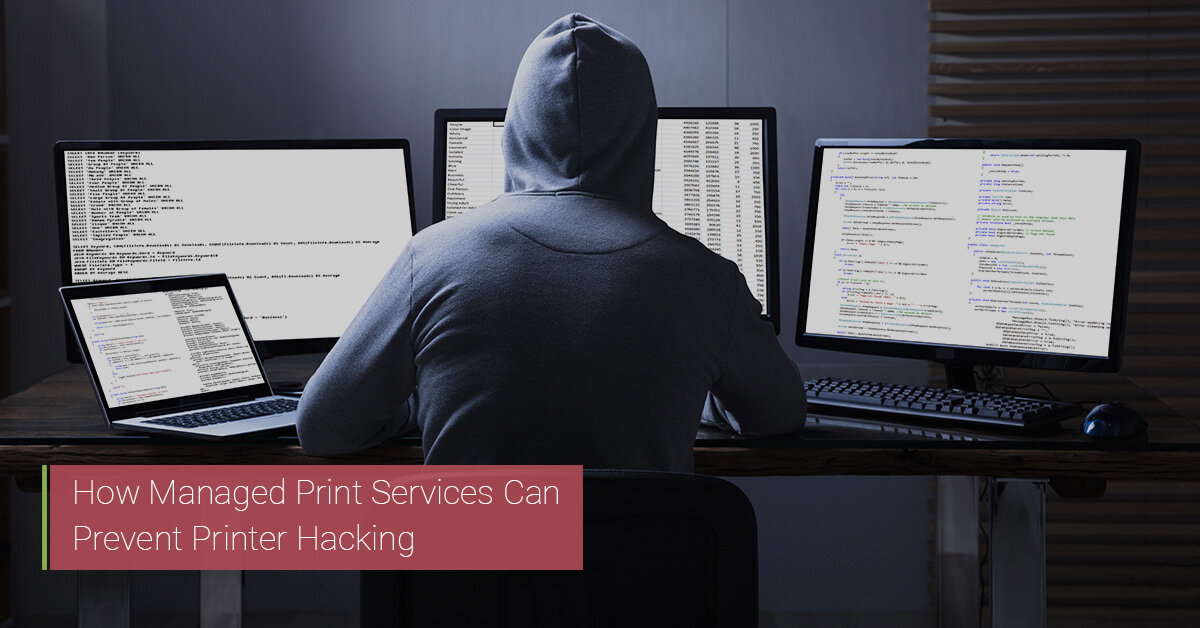Hackers are always discovering new and innovative ways to steal data, and the digital reality of modern businesses mean they often have no trouble doing it. Printer hacking is one such method – after all, who knew a printer could be hacked?
Printers are repeatedly proving to be a major vector by which cyber attacks occur. Nonetheless, offices keep overlooking them because it’s hard to imagine that the modern printer is technically a computer. Yet sensitive documents are routinely passed through this device, making them a veritable goldmine for thieves.
Is the fact that an office printer can be hacked news? It may be time to consider how managed print services can assist with keeping the company’s private information safe.
Why Printers Are Vulnerable
Despite the fact that printers play a highly visible role in any office, printer security generally remains unsecure. This is a paradoxical situation which arises mostly from the way companies view and manage their printing fleet. Three reasons exist why printer hacking occurs so prolifically:
1. Companies forget that printers are computers.
The average modern printer has a hard drive and a Wi-Fi connection. That’s everything a hacker needs to be able to access it – printers don’t even need to be “smart.” However, printers don’t look like computers and they certainly don’t get used like one. Therefore, it’s easy to forget to include them in a company cybersecurity strategy plan.
2. They’re not always visible on a network.
Printers are often invisible on a network. Sometimes, that occurs because they simply vanish in the list of connected devices. Other times, it occurs because a network is not configured to show them. In both cases, out of sight is out of mind, and their security gets overlooked.
3. Employees are rarely trained on printer security.
The employee manual may mention not leaving sensitive information in the printing tray, but does it mention how to safely and securely access the printing environment? Probably not. Like fax machines, printers suffer from the perception that they’re inherently secure because, again, they’re not computers. Therefore, no special training necessary. This illusion, however, is exactly what hackers bank on when they break into a printer.
4. Printer firmware doesn’t always get updated.
Software and operating system updates are familiar – if not sometimes annoying – and necessary routine updates which help patch security holes before the wrong person finds them. Firmware, the type of software which controls the functions of many types of electronic devices, also needs to be periodically updated. However, since there’s no user-facing side of firmware, it likewise gets forgotten about. The result is that firmware goes unpatched for longer, giving hackers the chance to find an entry.
How Hackers Attack Printers
Printers are susceptible to a variety of attacks. Most of these attacks target the hard drive, which is frequently the most vulnerable part of a printer. There are two primary ways in which hackers compromise printers:
1. By installing malware on the printer itself.
Printer malware is software that’s installed on the hard drive itself. Much like with a desktop computer, such malware can take many forms, ranging from ransomware to data tracking and more. Sometimes, the malware can take over the printer entirely, causing it to print things.
In 2018, for instance, someone hacked printers all around the world so they all printed advertisements to subscribe to a YouTube channel in order to help Swedish vlogger PewDiePie win a contest. While humorous, the attack grabbed attention because it perfectly illustrated the critical state of printer security.
2. By using the printer to access other parts of the network.
Hacking a printer provides access to more than just the printer functions. Once inside a printer, a hacker can also access other parts of the network which are likely better protected at their respective endpoints. It’s a lot like breaking into a house by entering through an unlocked window after having found all the doors locked. A printer often represents the soft underbelly of a security policy.
Managed Print Services and Security Work Together
It can be tempting to think of cyber security as a discrete part of office infrastructure. In reality, cyber security relies on policies and practices to provide security. Managed print services can help companies develop a secure print environment by:
- Implementing security software on printers.
- Providing guidance for printing policies to control physical access to devices.
- Maintain up to date printer firmware.
- Educate staff on safe printer use.
Prevent Printer Hacking Today
Printers often constitute a major weakness in a security policy. However, with the help of an inveterate professional, a business can secure it’s print environment completely. Cartridge World Quad Cities has been providing managed print services to companies to prevent printer hacking since 2004.
Businesses trust our experts to identify blind spots in security policies and develop printing infrastructure which streamlines productivity and amplifies security. Contact us today to get started securing your printing environment.
